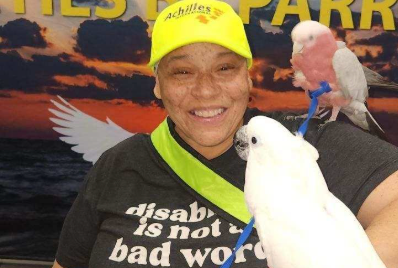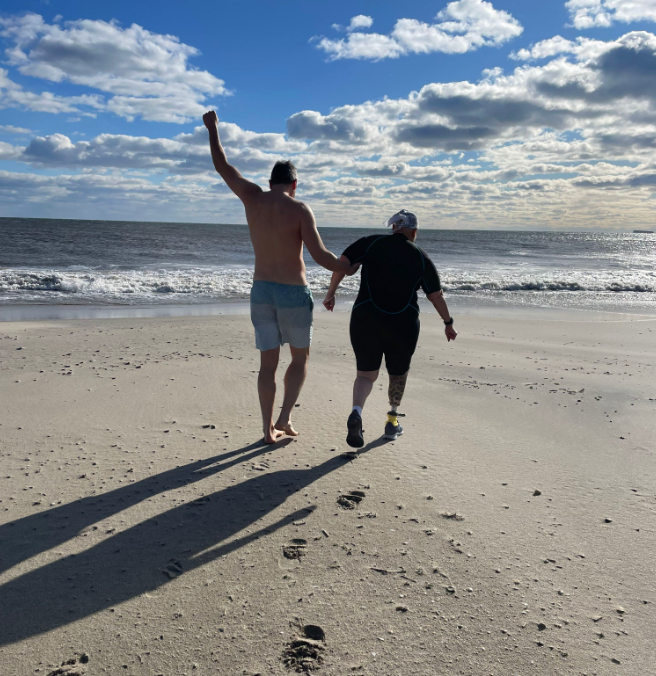After amputation, losing more of her leg was the only way to help her walk again
When Tracey White started feeling pain in her right foot after a half marathon in the spring of 2021, she thought it was just normal soreness from the race. But the ailments kept escalating.
In May 2021, a doctor diagnosed her with diabetic neuropathy, which damages nerves in the legs and feet. In July, an injury to her foot became septic and required surgery. That's when she learned she had a condition called Charcot's foot, which is caused by nerve damage and leads to repeated fractures and dislocations.
She began to treat the condition but still dealt with pain and discomfort from the July injury. In November 2021, three days before her 57th birthday, her right foot "broke in half," White said.
"My daughter had to rush me to the hospital, where I only had minutes before they had to tell me that they couldn't save my leg," White, now 60, said.
White had known that amputation was a risk of Charcot's foot but had hoped the day would never come. Doctors completed a below-the-knee amputation of her right leg.
At first, things were going well. But as White tried to heal, she began to struggle with pain around the site of the amputation. She started to experience pain every time she used her prosthetic limb. No amount of modifications seemed to help.
While attending a seminar about amputation pain, she met a doctor who suggested she undergo revision surgery, where more of the limb is removed to help reduce pain and make a prosthetic fit more smoothly. Her prosthetist agreed, and she eventually made an appointment with Dr. Omri Ayalon, an orthopedic surgeon at NYU Langone. He was able to explain to White that the angle of her bone and muscle was causing her pain.
"He explained it to me as, 'Picture a knife constantly stabbing you,'" White said. "I went into a panic, a rage, I started crying. He says 'Don't worry.'"
"The leg itself had to be changed"
Revision amputations are follow-up operations done to improve how a limb functions. Dr. Justin Greisberg, orthopedic surgeon and chief of the Foot and Ankle Service at NewYork-Presbyterian/Columbia University Irving Medical Center, who was not involved in White's care, said they are usually done in three scenarios: If an infection returns, if there is an irritated nerve, or if the bone is not working well under the muscle. The last one is what happened to White.
Revision surgeries are not common, Greisberg said. They typically are done at least several months after the initial amputation, when it becomes clear that the prosthetic "can no longer work without it" being done. Revision surgeries don't mean the initial operation was flawed, he said.
"Even though you may have done a great surgery, the tissues can shrink or atrophy. Swelling can go down, and all of a sudden there's bony prominences that are more noticeable," he explained.
Ayalon emphasized that the need for a revision amputation wasn't "anyone's fault," and said that White's prosthetists had done everything they could to make the new limb fit.
"It wasn't able to be done with just external means," Ayalon said. "The leg itself had to be changed, with more padding on the bone to allow the skin and soft tissue to heal appropriately."
"I still want that marathon moment"
White's revision surgery, performed by Ayalon, went smoothly. White spent several months afterward using a wheelchair and crutches. Soon, she was back in physical therapy so she could get back to relying on just her prosthetic leg.
This time, there was much less pain, she said. The revision amputation "has been a lifesaver," she said.
Recovering from the revision surgery meant missing one of her favorite activities: An annual New Year's Day polar bear plunge. White has been doing the plunge in New York City since she turned 50. When Ayalon told her she would have to miss a year to let her leg recover, she was disappointed — until he promised to do it with her the following winter.
After months of recovery and physical therapy, the day came in January 2025. It was windy, and temperatures were in the mid-20s. But that didn't deter the pair.
"We just went and jumped in the water. We had a ball," White said.
Ayalon recalled the day as "very cold, but very fun."
White will continue seeing Ayalon for check-ups, he said. Those check-ups will monitor her physical therapy and prosthetic care and "make sure everything is going well," Ayalon said.
Outside of the doctor's office, White is trying to get back to competitive running. After the revision amputation, she was able to participate in a four-mile "Hope and Possibility" run that celebrated people with disabilities.
"It was the toughest thing ever. I really wanted to give up, and my daughter said 'That's not an option. You don't give up. We don't give up,'" White recalled. "I had a lot of folks cheer me on, and I did cross the finish line and get my medal at the finish line, but I still want that marathon moment."






